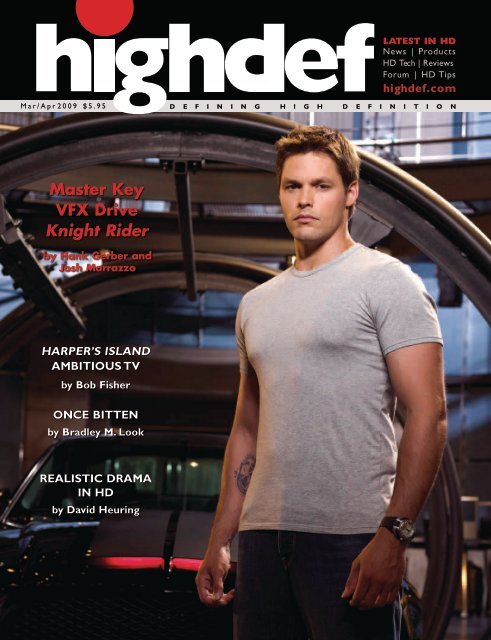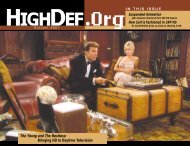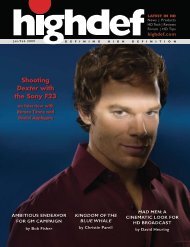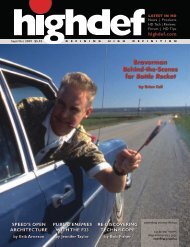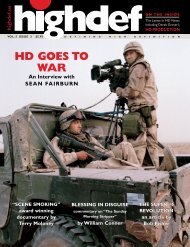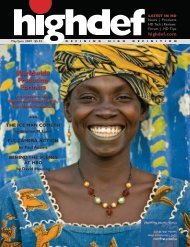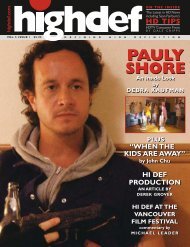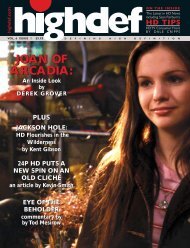Master Key VFX Drive Knight Rider - HighDef
Master Key VFX Drive Knight Rider - HighDef
Master Key VFX Drive Knight Rider - HighDef
Create successful ePaper yourself
Turn your PDF publications into a flip-book with our unique Google optimized e-Paper software.
News | Products<br />
HD Tech | Reviews<br />
Forum | HD Tips<br />
M a r / A p r 2 0 0 9 $ 5 . 9 5<br />
<strong>Master</strong> <strong>Key</strong><br />
<strong>VFX</strong> <strong>Drive</strong><br />
<strong>Knight</strong> <strong>Rider</strong><br />
by Hank Gerber and<br />
Josh Marrazzo<br />
Harper’s island<br />
ambitious tv<br />
by Bob Fisher<br />
Once Bitten<br />
by Bradley M. Look<br />
Realistic drama<br />
in HD<br />
by David Heuring
c o n t e n t s<br />
highdef.com<br />
6<br />
F e a t u r e<br />
<strong>Master</strong> <strong>Key</strong> <strong>VFX</strong> <strong>Drive</strong> <strong>Knight</strong> <strong>Rider</strong><br />
by Hank Gerber and Josh Marrazzo<br />
6<br />
12<br />
Waking the Baby Mammoth<br />
by Licet Ariza<br />
14<br />
HDTV Forum: CEA/USC Say Home 3D’s Time is Now<br />
by Steve Sechrist<br />
12<br />
18<br />
HD Tips: Choosing the Best Tools<br />
by B. Sean Fairburn<br />
19<br />
Harper’s Island, Ambitious TV<br />
by Bob Fisher<br />
20<br />
The Sweet Lady with the Nasty Voice<br />
by David Royle<br />
As if digitAl CApture didn’t<br />
hAve enough ChAllenges<br />
AlreAdy.<br />
KodaK Vision3 250d Color negative Film 5207/7207<br />
19<br />
21<br />
22<br />
24<br />
Sony XDCAM in the Galapagos<br />
by William Wheeler<br />
Once Bitten<br />
by Bradley M. Look<br />
Light and Lean<br />
by Jim Watt<br />
is the newest member of the KODAK VISION3 Film platform. Offering<br />
the highest resolution available, VISION3 Films continue to raise the<br />
22<br />
25<br />
Built it Bigger in HD<br />
by Andrew Scafetta<br />
bar with unrivaled highlight latitude and reduced grain in shadows<br />
for greater flexibility and control in post. Combine that with film’s<br />
proven archival capabilities and you have the state-of-the-art image<br />
26<br />
Cameras Fly High with Fiber Optics Cable<br />
by Ed Sullivan<br />
capture medium that others can only aspire to. Why try to emulate<br />
film when you can have the real thing? Film. No compromise.<br />
Learn more at www.kodak.com/go/250d<br />
28<br />
28<br />
Realistic Drama in HD<br />
by David Heuring<br />
30<br />
Catching the Waves with the HPX170<br />
by Brian Cali<br />
Front Cover: Justin Bruening as Mike Traceur, estranged son of Michael <strong>Knight</strong>, in <strong>Knight</strong> <strong>Rider</strong> (The Series). Photo by Mitchell Haaseth<br />
© Kodak, 2009. Kodak and Vision are trademarks.<br />
Vol. 11, Issue 2 | <strong>HighDef</strong> Magazine is published bi-monthly, free for professionals in all areas of video and film production, nationally by American Press Services, 2247 15 th Avenue West, Seattle,<br />
WA 98119. PUBLISHER: Conrad W. Denke EDITOR: David W. Thompson PRODUCTION: Gina Griffin Hanzsek DISPLAY ADVERTISING: Call David Thompson at 1-888-282-1776 or e-mail<br />
david@highdef.com. Deadline for advertising mechanicals is fifteen(15) days prior to publication date. Current and back issues and additional resources, including subscription request forms, are<br />
available on our website: www.highdef.com. Address changes can also be done online at www.highdef.com/subscribe or mail changes to: <strong>HighDef</strong> Magazine, 2247 15 th Ave. West, Seattle, WA<br />
98119. PRINTER: RR Donnelley, www.rrdonnelley.com
N E W S & P R O D U C T S<br />
where do you draw the line between master quality<br />
and affordability?<br />
Panasonic AG-HPG20 P2<br />
Recorder/Player<br />
Panasonic announced its new solidstate<br />
AG-HPG20 P2 Portable recorder/<br />
player. With AVC-Intra, DVCPRO<br />
HD/50/25 and DV compatibility, the<br />
HPG20 P2 Portable is a 10-bit, 4:2:2<br />
master-quality deck for fast, file-based<br />
recording and, with removable solidstate<br />
cards, offers recording times that<br />
exceed those of tape or optical disc<br />
based products. Offering greater P2<br />
workflow flexibility, a bridge to higher<br />
recording quality or tapeless workflow<br />
for older HD-SDI equipped cameras,<br />
and a solution to a multitude of other<br />
high quality recording challenges, the<br />
HPG20 dramatically reduces the cost<br />
for these capabilities. It has a suggested<br />
list price of $5,295.<br />
JVC GY-HM700 ProHD<br />
Camcorder<br />
JVC’s GY-HM700 is its latest Compact<br />
Shoulder professional camcorder<br />
developed for mainstream production,<br />
electronic newsgathering and<br />
cinematography. The camera records<br />
directly to SDHC memory cards in the<br />
QuickTime (.MOV) format for Final Cut<br />
Pro, and optionally to SxS media<br />
compatible with Sony’s XDCAM EX<br />
format. Recording in the editing system’s<br />
native format eliminates the time<br />
consuming transfer step and dramatically<br />
speeds up the post-production<br />
workflow. Additionally, the GY-HM700<br />
includes several key technology<br />
innovations that result in significantly<br />
improved resolution in the camera’s<br />
core components: CCD/optical block,<br />
lens, and viewfinder.<br />
NY Giants Train with Sony<br />
XDCAM<br />
The New York Giants have begun training<br />
in a new facility fully equipped with<br />
Sony professional HD production technology.<br />
Sony’s XDCAM HD422 optical<br />
camcorders, model PDW-700, will be<br />
used as EFP cameras to capture a<br />
variety of video elements for the team<br />
and the fans. PDW-HD1500 XDCAM<br />
decks will also serve as the Giants’<br />
house recording format. The facility will<br />
open in June within the Meadowlands<br />
Sports Complex where the Giants play<br />
home games, and will house a full HD<br />
control room including Sony HDC-1400<br />
studio cameras, an MFS-2000 production<br />
switcher, HDCAM decks and<br />
LUMA LCD monitors.<br />
FOR-A Multi-Format<br />
Switcher<br />
The FOR-A HVS-300HS features a<br />
compact 1RU main unit, making it an<br />
ideal solution for use in flight packs,<br />
mobiles or small production facilities.<br />
Standard resizing engines on all inputs<br />
of the HVS-300HS make it possible<br />
to mix SD and HD signals in a full HD<br />
production. Optional analog and DVI/<br />
WUXGA input modules enable the<br />
use of legacy SD equipment. Standard<br />
frame syncs, available on each input,<br />
eliminate the timing issues involved<br />
with mixed signal installations. Plus,<br />
optional output modules each contain<br />
one channel of down conversion to<br />
feed existing SD systems. The HVS-<br />
300HS supports 1080/60i, 59.94i, 50i,<br />
24PsF, 23.98PsF, 720/60p, 59.94p, 50p,<br />
525/60 (NTSC), and 625/50 (PAL).<br />
LDS Church HD Truck with<br />
Fujinon Lenses<br />
The Church of Jesus Christ of Latterday<br />
Saints (LDS) has acquired a<br />
complement of Fujinon HD lenses<br />
for the Church’s newly constructed<br />
42-foot HD production truck based in<br />
Salt Lake City, Utah. The HD mobile<br />
production unit is equipped with a<br />
new lens package that includes two<br />
XA72x9.3BESM telephoto lenses, three<br />
HA22x7.3BERD ENG-style lenses, and<br />
one HA13x4.5BERD wide angle ENG/<br />
EFP with 2X range extender. The six<br />
Fujinon lenses are mounted on Sony<br />
HDC-1500 HD cameras. The truck<br />
will be used for productions ranging<br />
from live addresses by Church leaders<br />
broadcast to worldwide audiences, to<br />
recording large scale musical events<br />
with the Mormon Tabernacle Choir<br />
and concerts from Brigham Young<br />
University.<br />
Panasonic Affordable<br />
10-bit, 4:2:2 Camera<br />
Panasonic unveiled the world’s first<br />
affordable 10-bit, 4:2:2 professional HD<br />
camcorder, featuring individual frame<br />
AVC-Intra recording, native 2.2-megapixel<br />
imagers and variable frame<br />
rates. Incorporating an innovative, low<br />
profile shoulder mounted design, the<br />
1/3” AG-HPX300 P2 HD camcorder<br />
offers the flexibility of interchangeable<br />
lens but comes standard with a<br />
17x HD Fujinon lens. Delivering the<br />
impressive quality of AVC-Intra 100 and<br />
AVC-Intra 50, the HPX300 also records<br />
individual frame images in 100Mbps<br />
DVCPRO HD and in standard definition<br />
in DVCPRO50, DVCPRO and DV.<br />
The AVC-Intra 100 and 50 codecs allow<br />
recording in a choice of HD video<br />
formats: 1080/59.94i, 1080/29.97P and<br />
1080/23.98P (native 24p/30p), and<br />
720P with variable frames in 23.98pN,<br />
29.97pN and 59.94P. It’s suggested list<br />
price is $10,700.<br />
New Vision Rolls-out HD<br />
With Sony<br />
New Vision Television Group has completed<br />
the first phase of its conversion<br />
to full HD operations. The company<br />
is rolling out 130 Sony tapeless highdefinition<br />
camcorders across its 17<br />
owned-and-operated stations—a<br />
combination of XDCAM HD422 optical<br />
PDW-700 camcorders and the compact<br />
Express Card-based PMW-EX3 with<br />
the Nipros optical fiber studio adapter.<br />
The purchase of the XDCAM systems<br />
completes New Vision’s first phase,<br />
which will continue to develop as part<br />
of a long-term plan, according to Lynn<br />
Rowe, chief technology consultant for<br />
the company. HD<br />
in a fi eld of its own<br />
If you dream of shooting 10-bit 4:2:2 master quality but believe you can’t afford it, the new AG-HPX300 P2 HD camcorder<br />
changes your dreams into reality. With a $10,700 list price, the HPX300 is the world’s fi rst affordable 10-bit 4:2:2<br />
camcorder. And there’s nothing even close. With a standard 17X interchangeable lens and newly-developed three 1/3"<br />
2.2 megapixel 3-MOS imagers, you can record 1080 and 720 HD as well as SD content using master-quality AVC-Intra,<br />
DVCPRO HD, DVCPRO50, DVCPRO and DV compression — all with the benefi t of P2’s faster, independent frame,<br />
fi le-based workfl ow. As rich in creative features as it is in style, the HPX300’s innovative, low profi le, shoulder-mount<br />
design lets you shoot freely through a beautiful, master-quality world. It’s no longer a dream. The HPX300 is here.<br />
Visit www.panasonic.com/p2hd.<br />
when it counts<br />
Shown with optional<br />
wireless mic receiver.<br />
4<br />
© 2009 Panasonic Broadcast
KITT (known also as<br />
<strong>Knight</strong> Industries Three<br />
Thousand) is a 2008<br />
Ford Shelby GT500KR<br />
Mustang, equipped<br />
with new weapons, a<br />
completely redesigned<br />
attack mode, and more<br />
transformation abilities<br />
from <strong>Knight</strong> <strong>Rider</strong> - NBC.<br />
<strong>Master</strong> <strong>Key</strong> <strong>VFX</strong> <strong>Drive</strong><br />
<strong>Knight</strong> <strong>Rider</strong><br />
Photo by Paul Drinkwater<br />
b y H a n k G e r b e r a n d J o s h M a r r a z z o<br />
<strong>Knight</strong> <strong>Rider</strong>, broadcast in HD by NBC, is an update of the cult-classic 1980s series, reimagined<br />
by showrunner Gary Scott Thompson, Executive Producers Glen A. Larson,<br />
Doug Liman and Dave Bartis (of the Bourne movies). Though the action and setting are<br />
modernized, the premise remains faithful to the original: follow the world-saving adventures of<br />
Michael <strong>Knight</strong> (Justin Bruening) and his Ford Mustang cyber-car-with-an-attitude KITT (voiced<br />
by Val Kilmer).<br />
<strong>Knight</strong> might be the action hero saving the day, but KITT does even more: speeding<br />
through explosions, transforming into other vehicles (one favorite: a souped-up pickup), offering<br />
an arsenal of weapons to escape dangerous situations, and displaying hologram visual info<br />
at a finger’s touch. The re-vamped, super-stylized show offers an interesting challenge to the<br />
producers: create 200-300 effects per weekly episode.<br />
Enter <strong>Master</strong> <strong>Key</strong> Visual Effects.<br />
The company was founded by Elan Dassani, who had several years of experience supplying<br />
playback <strong>VFX</strong> on other projects, and his brother Rajeev, a USC graduate and Student Academy<br />
Award winner. The Dassanis supplied graphics for <strong>Knight</strong> <strong>Rider</strong>’s pilot, so they were already<br />
familiar with the visual effects challenges they would be encountering as the series moved into<br />
fast-forward.<br />
6 7
www.aja.com<br />
“AJA makes the whole process easier.”<br />
Rendering images courtesy of NBC<br />
Above Left: 100% CGI build<br />
of “KITT in Attack” mode<br />
speeding through a secret<br />
tunnel into the SSC. This shot<br />
was rendered in 3D Studio<br />
Max with over 15 passes and<br />
composited in Adobe After<br />
Effects. Time to completion -<br />
one week.<br />
Above Right Top: Wireframe<br />
representation of “KITT in<br />
Tunnel” showing polygonal<br />
construction of the scene.<br />
Above Right Bottom:<br />
Rendered model and<br />
environment for “KITT in<br />
Tunnel” scene. Lighting is<br />
there, but only the default<br />
shader is used for texturing.<br />
8<br />
Their first step was to hire Stephan Fleet,<br />
another USC grad, who had just finished<br />
producing two seasons of effects-heavy, TV<br />
Guide Award-winning webisodes of Ghost<br />
Whisperer. Fleet, with a background in custom-creating<br />
workflows, would be a vital tool<br />
in producing <strong>Knight</strong> <strong>Rider</strong>’s weekly <strong>VFX</strong>.<br />
Originally <strong>Master</strong> <strong>Key</strong> was brought in only<br />
to design and create effects for the hologramlike<br />
displays that appear on KITT’s windshield<br />
. Once producers saw <strong>Master</strong> <strong>Key</strong>’s speed<br />
in creating imaginative, high-quality effects,<br />
it wasn’t long before they found themselves<br />
responsible for the entire allotment of each<br />
episode’s <strong>VFX</strong>.<br />
To accomplish this, they expanded into<br />
offices on the Santa Clarita Studios lot, and<br />
their staff grew to thirty. Most of the employees<br />
are hands-on effects artists, several have<br />
extensive production credits, all are fans of<br />
effects-driven stories, action and animé, and<br />
<strong>Master</strong> <strong>Key</strong> can count at least one comic book<br />
writer among its diverse little family.<br />
First unit live-action is shot on a Sony<br />
F23 with no LUT colorspaces, fed directly to<br />
HDCAM SR at 1080p 444. crash-cams and<br />
B-cameras use Iconix and Sony EX1 cameras.<br />
During the first days of production <strong>Master</strong> <strong>Key</strong><br />
did not have budget or access to that equipment,<br />
so Rajeev Dassani and Stephan Fleet<br />
grabbed up a Panasonic HVX200 for original<br />
tests on KITT’s transformations. Those tests<br />
were impressive enough to be used intact last<br />
summer for NBC’s <strong>Knight</strong> <strong>Rider</strong> theatrical trailers<br />
and Olympics-timed advertising.<br />
Their “fan-based commitment to the<br />
story,” as one fan-blogger wrote, is what<br />
drives <strong>Master</strong> <strong>Key</strong>’s approach to the practical<br />
aspects of maintaining a high standard,<br />
deadline-driven workflow. Working from<br />
storyboard sketches provided by <strong>Knight</strong><br />
<strong>Rider</strong>’s art department, veterans of Star Wars:<br />
Episode One and the like, <strong>Master</strong> <strong>Key</strong> divides<br />
up the work into three stages. First step:<br />
Create the concept for the effects, in black<br />
& white Photoshop images. Next: Modeling,<br />
primarily using 3D Studio Max with the V-Ray<br />
Rendering engine. Finally: Composite the 3D<br />
renderings onto layered 2D mattes for insertion<br />
back into the edited 1080p HDCAM 444<br />
10-bit master of the entire show, using Adobe<br />
After effects CS3 with the <strong>Key</strong> Correct plug-in<br />
suite, plus a few other boutique plug-ins.<br />
This is done barely one step behind<br />
the live action shoot. To deal with the time<br />
crunch, there is a lot of anticipation of how<br />
the actual action will be edited. “But that’s<br />
one advantage of working on a series,” says<br />
Fleet. “Unlike a movie where everything is<br />
new and generally one-time, we’ve become<br />
an ‘actor’ in this process, so we build upon<br />
past weeks ‘character’ work and can fairly<br />
accurately guess what KITT will do in any<br />
given situation.” The creative process in<br />
the <strong>Master</strong> <strong>Key</strong> effects suites reflects this<br />
approach, with humanizing phrases like “they<br />
• 10-bit, full-resolution SD/HD over FireWire<br />
• Apple ProRes 422 codec in hardware –<br />
HD 720/1080, SD NTSC/PAL<br />
• Up/down/cross-conversion, hardware-based and realtime<br />
• Connect via a single FireWire cable to<br />
MacBook Pro or MacPro<br />
I o H D . B e c a u s e i t m a t t e r s .<br />
Keith Collea<br />
Co-writer and Producer, The Gene Generation<br />
From capture to conversion, Keith Collea’s entire<br />
post production workflow relies on AJA at its core.<br />
With a resumé including work on blockbusters such as ‘Alien:<br />
Resurrection’, ‘Independence Day’ and ‘Pearl Harbor’, the effects and<br />
post production veteran has been a longtime user of AJA products.<br />
Collea’s entire post production workflow depends on AJA products,<br />
including KONA, Io HD, and Converters. “I’m a huge AJA fan,” says Collea.<br />
On his recent feature, ‘The Gene Generation’, Keith chose Io HD as the<br />
centerpiece of a fully portable projection system. “Using the Io HD, an<br />
Apple Intel MacBook Pro and a G-Tech G-DRIVE, we were able to create<br />
a system that allowed the film to be shown on a Sony digital cinema<br />
projector without the use of a tape-based VTR for playback,” he<br />
explained. “It saved us time and money, and the picture quality<br />
was better than if it came off of tape. It was just incredible.”<br />
To find out more about how Keith uses AJA products to enhance<br />
his workflow, check out the full details at www.aja.com/keith
High Rez render and<br />
composite from scene<br />
where KARR grabs Agent<br />
Torres and swallows him up.<br />
Multiple passes of KARR<br />
were designed in 3D Studio<br />
MAX then composited over<br />
HDCAM SR plate shot with<br />
a sony F23 (using no LUTs)<br />
captured via Black Magic<br />
10-bit 444, then converted<br />
to DPX sequences. Multiple<br />
passes were used for<br />
shadowing, z-depth, layering<br />
the hand grabbing Torres,<br />
the yellow highlights around<br />
KARR, directional lighting,<br />
and texturing.<br />
10<br />
Image © 2009 - MK<strong>VFX</strong> - All Rights Reserved<br />
touch almost affectionately” used to describe<br />
KITT’s actions and interactions.<br />
To achieve character continuity and solve<br />
deadline issues, Fleet, a director himself and<br />
former child actor, developed several effects<br />
templates during the first weeks of the series.<br />
Those templates are now as much a part<br />
of KITT’s “character” as Val Kilmer’s voice<br />
— including a “thinking matrix” dashboard<br />
hologram effect that “seems to be used by<br />
everybody else in television now, but we had<br />
to make it up first.”<br />
With the emphasis on character in KITT’s<br />
effects, the way to achieving that end is<br />
<strong>Master</strong> <strong>Key</strong>’s devil-in-the-details approach to<br />
designing the actual executions of the <strong>VFX</strong><br />
desired. “We pay a lot of attention to the live<br />
action camera work and try to emulate it with<br />
our own backplate shots (using the HVX200)<br />
and 3D modeling to create matching grain,<br />
lens effects, and movement, like the slight<br />
shake of a handheld shot, or whip zooms for<br />
dramatic impact.”<br />
A recent example of this approach:<br />
developing KITT’s cyber-car nemesis from the<br />
original series, KARR. The creative process<br />
started with Elan Dassani and Fleet sitting<br />
down with showrunner Thompson and asking<br />
what he wanted.<br />
“This was a big deal,” says Dassani,<br />
“because we have hardcore fans of the original<br />
series and they have definite ideas about<br />
KARR — but we also have new fans who want<br />
the current standard in action. And we have<br />
Gary Scott Thompson, who wrote The Fast<br />
and The Furious, who definitely has his ideas<br />
and stamp on this show.” Adds Fleet: “So we<br />
listened, did a lot of research into old shows<br />
and new movies where machines are characters,<br />
then we went crazy with our creative<br />
ideas – some of it looked goofy at first – until<br />
we zoned in on KARR’s key qualities.”<br />
One of the key qualities: KARR is as much<br />
a character as KITT. Most important physical<br />
attribute: KARR transforms from a car to a<br />
wheel-legged robot. “When KARR transforms,<br />
we want him to feel it in his belly,” one effects<br />
artist explained.<br />
Meanwhile, as another visual prompt,<br />
the <strong>Master</strong> <strong>Key</strong> team decided that KARR’s<br />
“skin” would be reflective of his surroundings.<br />
“We’re shooting for HD presentation,” says<br />
Rajeev Dassani, who heads the 3D modeling<br />
team. “A lot of the detail we add may not<br />
show up on standard def, but for those watching<br />
on hi-def, KARR is an awesome creature.<br />
You can see the people KARR sees reflected<br />
in his chest, overhead lights glisten on his<br />
‘arm’ muscles, and so on.” To achieve that<br />
end, <strong>Master</strong> <strong>Key</strong> went to the live action set<br />
and shot their own POVs of the actors, who<br />
were interacting with an invisible KARR. The<br />
result was a seamless HD-driven crossflow of<br />
live action and animation.<br />
While <strong>Knight</strong> <strong>Rider</strong> is wrapping up production<br />
for the current television season,<br />
<strong>Master</strong> <strong>Key</strong> is ramping up for other projects.<br />
Those projects span a range from “dream<br />
sequence” backgrounds for Player, an<br />
HVX200-shot feature, to their own sci-fi TV<br />
pilot, Terminal Case. Meanwhile, <strong>Master</strong> <strong>Key</strong><br />
is working with other television productions<br />
while staying on-call for <strong>Knight</strong> <strong>Rider</strong>’s hopedfor<br />
second season. HD<br />
<strong>Master</strong> <strong>Key</strong>’s visuals can be visited at http://<br />
mkvfx.com. <strong>Knight</strong> <strong>Rider</strong> has several behind-thescenes<br />
interviews and visuals at http://knightrideronline.com/news<br />
Hank Gerber is based out of Los Angeles and<br />
has been a freelance writer and professional unit<br />
publicist for the past 25 years.<br />
Josh Marrazzo is a freelance writer currently living<br />
in Burbank, CA. His TV credits include such<br />
shows as NBC’s Heroes and <strong>Knight</strong> <strong>Rider</strong>.<br />
optimo rouge<br />
Following the tremendous success of the Optimo Rouge 30-80 lens – the first<br />
in the Optimo DP series – Thales Angenieux introduces the Optimo Rouge<br />
16-42 Wide Angle Zoom. It features a wide angle position of 16mm (75.4<br />
degrees), a fast aperture of T2.8, calibrated focus marks, no ramping or<br />
breathing all in a lightweight, compact 4.2 lb package. The Optimo Rouge<br />
16-42 Wide Angle Zoom delivers industry proven features with the performance,<br />
functionality and ergonomics that DP’s demand at a cost effective price. Only<br />
from Thales Angenieux.<br />
973.812.3858 • angenieux@tccus.com • www.angenieux.com<br />
wide<br />
images
Waking<br />
the Baby Mammoth<br />
b y L i c e t A r i z a<br />
Simply Perfect Together<br />
Photo by © Francis Latreille<br />
National Geographic Channel’s (NGC)<br />
Waking the Baby Mammoth sets out<br />
around the world on a cutting-edge<br />
paleo-detective investigation into the life and<br />
death of Lyuba, the most perfectly preserved<br />
baby mammoth ever found. Currently in production,<br />
the two-hour special features insight<br />
from the indigenous Siberian people who<br />
found her and the scientific community so<br />
captivated by her.<br />
Roughly 10,000 years after most of these<br />
giant creatures went extinct, Waking the Baby<br />
Mammoth takes viewers from the tundra of<br />
remote Siberia to scientific facilities in Japan,<br />
Europe and North America on a search for<br />
clues into their life and extinction. Viewers<br />
travel back to the ice age with Lyuba via CGI<br />
animation and then fast-forward to the present<br />
to reveal the latest innovations in woolly<br />
mammoth research, including advanced<br />
computed tomography scanning and DNA<br />
analysis that may shed light on the history of<br />
Earth’s changing climate.<br />
Cinematographer Pierre Stine used a<br />
Sony HDCAM 790. “I prefer to shoot in HD<br />
using this camera because there are many<br />
tools in the menu that allow you to adapt the<br />
camera to almost any type of lighting condition,”<br />
says Stine. “The biggest challenge was<br />
the effect of the cold on the equipment. I was<br />
surprised by the tolerance of that camera.<br />
The main thing is to avoid temperature differences.<br />
For example, you have to avoid going<br />
straight from the outside where it’s -13°F<br />
(-25°C) to the inside where it’s 77°F (+25°C).<br />
The condensation can be a killer for the<br />
equipment.”<br />
For both Stine and executive producer<br />
Adrienne Ciuffo, the most memorable day of<br />
the shoot so far was seeing Lyuba for the first<br />
time. “I was very moved,” says Ciuffo. “This<br />
baby looks like you could snap your fingers<br />
and she would wake up and walk.” HD<br />
Panasonic VariCam® shown with Canon HJ11x4.7B KLL-SC HD-EC Zoom Lens.<br />
Above: In May 2007, fifty-five<br />
year old Yuri Khudi (center)<br />
discovered a nearly perfectly<br />
preserved four month old<br />
baby mammoth on the shore<br />
of a remote Siberian river.<br />
Right: Scientists perform<br />
microsurgery on Lyuba, a<br />
baby mammoth. Ten thousand<br />
years after her species<br />
became extinct, she is in<br />
amazing condition and unlike<br />
any other animal ever dug<br />
out of the frozen earth.<br />
Panasonic’s VariCam ® and Canon’s HD-EC Lenses<br />
Panasonic’s acclaimed VariCam ® 2/3-inch digital<br />
HD motion picture camera and Canon’s costeffective<br />
HD-EC family of six Prime lenses and<br />
three Zoom lenses are simply perfect together.<br />
VariCam ® ’s innovative CineGamma technology<br />
reflects the refinements of many cinematographers<br />
and fully exploits the camera’s wide dynamic range.<br />
VariCam ® ’s 720-line 60-progressive-frame digital<br />
imagery exhibits remarkable sharpness by fully<br />
capitalizing on the high MTF optical imagery<br />
delivered by Canon’s HD-EC lenses. The superb<br />
black reproduction of these lenses and their<br />
well-controlled light distribution ensure the<br />
highest contrast across the 16:9 image plane.<br />
And Canon’s innovative ACV-235 Anamorphic<br />
Converter, which optically compresses widescreen<br />
2.35:1 aspect ratio imagery to the 16:9 format,<br />
provides remarkably fine widescreen 35mm<br />
film-out image quality.<br />
12<br />
Photo by © Florent Herry<br />
For more info:<br />
Call 1-800-321-HDTV<br />
(In Canada: 905-795-2012)<br />
http://www.canonhdec.com<br />
VariCam ® is a registered trademark of Panasonic.<br />
See Us At NAB Booth #C4325<br />
©2009 Canon U.S.A., Inc. All rights reserved. Canon is a registered trademark of Canon Inc. in the United States<br />
and may also be a registered trademark or trademark in other countries. IMAGEANYWARE is a trademark of Canon.
hdtv<br />
Forum<br />
b y s t e v e s e c h r i s t<br />
CEA/USC Say Home 3D’s Time is Now<br />
Steve Sechrist is<br />
an editor/analyst<br />
at Insight Media, a<br />
technology based<br />
media firm specializing<br />
in large format and<br />
micro display and<br />
related industries.<br />
JVC 3DTV a 46-inch<br />
LCD prototype shown<br />
at CEATEC Japan last<br />
October.<br />
14<br />
The CEA and the Entertainment and<br />
Technology Center at the University of Southern<br />
California just finished a study on consumer attitudes<br />
towards 3D. Suffice it to say they conclude<br />
that 3D is a force that will only grow with exposure.<br />
The more 3D content consumers see, the<br />
more people want to continue watching 3D.<br />
Their findings include:<br />
• 16% and 14% of respondents wanted 3D films<br />
and video games (respectively) in the home.<br />
• More than 26M households are interested in<br />
having a 3-D content experience in their own<br />
home.<br />
• +50% of U.S. adults said having to wear<br />
special glasses or hold their heads still while<br />
watching a 3-D TV would have no impact on<br />
them purchasing a 3-D set for their home.<br />
• 15 % of consumers said they would spend<br />
roughly 25% more for a 3D TV.<br />
• 30% of U.S. adults said having access to 3-D<br />
content though cable, satellite, fiber-optics<br />
or over-the-air broadcasts would positively<br />
impact their decision to buy a 3-D capable TV.<br />
The point to this study may just be that 3D<br />
technology has transcended the novel/hobby<br />
stage and is on a true vector toward mainstream<br />
home adoption. The reason for this perhaps,<br />
is that 3D technology sufficiently overcame a<br />
major obstacle to its adoption: 3D content.<br />
And content is no problem, as USC E&T<br />
Center’s David Wertheimer noted “In the past<br />
few weeks alone, we’ve seen college football’s<br />
national championship game, multiple Super<br />
Bowl commercials and an hour-long TV show,<br />
all broadcast in 3-D. While there is still much<br />
to learn in content creation, the industry is taking<br />
an iterative approach. Much like Edison<br />
who discovered 10,000 ways NOT to make the<br />
incandescent light bulb, both the film and live<br />
broadcast industries are learning the best way to<br />
deliver 3D by simply doing—and evaluating the<br />
results and feedback.”<br />
The fact is, 3D content is booming for the<br />
simple reason that studio’s can charge more for<br />
seats, and digital movie theaters can leverage<br />
their recent investments in digital cinema technology—not<br />
only with films, but live 3D events<br />
that have captured the mindshare of the next<br />
generation. There is now so much content in the<br />
Hollywood pipeline that moviemakers are beginning<br />
to worry about the availability of enough<br />
3D theater venues. And as in 2D film distribution,<br />
after the cinema the home becomes the<br />
next target market.<br />
So don’t get too attached to that big flat<br />
screen TV you just bought, thinking it would<br />
serve the next 10 years, as your living room portal<br />
to the digital millennium. You may just find<br />
it relegated to the bedroom (or garage – wow!)<br />
when your new 3D set arrives. HD
The Outdoor Channel airs over 300 hours of original programming<br />
per year. And has a new house format: XDCAM HD.<br />
“We opened eyes at the Outdoor Channel when we shot Spear Gun Hunter on XDCAM HD,”<br />
says Robin Berg, president of BEI Inc. and director of the new series, Savage Wild. “When they<br />
saw the durability, that was big. When they saw the possibilities for program exchange and<br />
archive, that was huge. And when they saw how well the footage matched far more expensive<br />
camcorders, they started converting their entire operation.” To hear the full story, visit us online.<br />
click: sony.com/xdcam<br />
— Robin Berg, Director<br />
© 2008 Sony Electronics Inc. All rights reserved. Reproduction in whole or in part without written permission is prohibited.<br />
Features and specifi cations are subject to change without notice. Sony, HDNA, the HDNA logo and XDCAM are trademarks of Sony.
hd<br />
Tips<br />
b y B . S e a n F a i r b u r n S O C<br />
B. Sean Fairburn, SOC<br />
Director of Photography,<br />
Role Model Productions,<br />
LLC. rolemodel@<br />
earthlink.net<br />
Seanfairburn.com<br />
818-621-3912<br />
Local 600,<br />
Agent Steve Jacob,<br />
323-460-4767<br />
Sony HDC 1500 on Boom.<br />
Choosing the Best Tools<br />
“Highdef is Brackish Water”<br />
you have heard me say in the<br />
past, but now more than ever<br />
the blending of film and video<br />
is easier.<br />
It’s amazing to me that<br />
when you analyze the needs<br />
of each project and decide<br />
clearly what needs to get<br />
accomplished, it will lead you<br />
to the best available tools to<br />
get the job done.<br />
A movie project in<br />
Kentucky brought me in to DP<br />
a very unusual project, using<br />
music as a metaphor for community.<br />
The foundation of the<br />
concept was a symphony performance<br />
shot in HD 29.97P<br />
on HDCAM SR shot with Sony<br />
HDC 1500 cameras in a traditional<br />
multi-cam environment<br />
mixed with many still cameras<br />
shooting high speed. In analyzing<br />
the project it was clear<br />
that we were there to harvest<br />
amazing images for the movie,<br />
not make the traditional<br />
live multi-cam performance.<br />
Extreme close-ups of parts of<br />
the instruments being played<br />
in the natural environment was<br />
the main goal. But in this case,<br />
it made more sense to capture<br />
the images not as a traditional<br />
film set, but more like a live<br />
video switched shoot.<br />
The result was a level of<br />
authenticity, speed and beauty<br />
that I must say was amazing<br />
to behold. Having had a life in<br />
video as a live multi-cam operator<br />
and director for music,<br />
long before highdef, I felt<br />
strangely comfortable calling a<br />
show once again after 15 years<br />
away from it. This time the<br />
dazzling beauty of the cameras<br />
and instruments were unlike<br />
anything I have seen before.<br />
A director with a clear vision,<br />
an amazing crew skilled in live<br />
performance, an HD to film<br />
specialist as DIT/Shader and<br />
engineers, all came together<br />
extremely well.<br />
I would encourage you<br />
to explore the mixing of how<br />
things best get done from<br />
stills to film to video to HD.<br />
Just as our visual vocabulary is<br />
growing, so should our technique<br />
and execution. Have fun<br />
and be sure to test it first. HD<br />
Harper’s Island<br />
b y B o b F i s h e r<br />
Harper’s Island’s story opens with an<br />
exterior wedding ceremony during<br />
a sunny day on a small island off the<br />
coast of Seattle. The pilot episode concludes<br />
with a guest murdered by an unknown assailant.<br />
The tension heightens as another person<br />
is murdered each week until the culprit is<br />
revealed during the 13th and final episode.<br />
“I hadn’t shot a full television series for 10<br />
years,” says cinematographer Rob McLachlan,<br />
ASC, CSC. “Expectations have radically<br />
changed with many millions of people now<br />
watching TV programs in HD format, including<br />
those with home theaters and plasma screens.”<br />
Jon Turteltaub directed the pilot episode<br />
and produced the series as a co-venture<br />
between his company Junction Entertainment<br />
and CBS Paramount Network Television. It<br />
was filmed almost entirely at practical exterior<br />
locations on a small island off the coast<br />
of Vancouver, Canada. The story takes place<br />
over an eight-day period. That was a significant<br />
challenge because they began production<br />
in late summer and ran into mid-winter<br />
when the days were shorter and darker.<br />
Ambitious TV<br />
McLachlan filmed the entire<br />
series on KODAK VISION3 5219<br />
500T negative, which he rated<br />
for EI 1000 for night and interior<br />
scenes that were produced<br />
with “incredibly little light.”<br />
McLachlan used Airstar balloons<br />
as a main source of lighting in<br />
the darkest environments.<br />
“There is a cohesive visual<br />
arc,” he says. “The first episode has a flat,<br />
warm, romantic look because it takes place<br />
in golden sunshine. We added a little saturation<br />
to the images to create a warm, golden,<br />
romantic aura by using diffusion filters on<br />
lenses. The hard part was maintaining visual<br />
continuity, and making exteriors that we shot<br />
on dismal winter days look like fall.”<br />
McLachlan took digital stills of every set<br />
up and used the Kodak Look Manager System<br />
(KLMS) and Adobe Photoshop Lightroom® to<br />
provide visual references for the dailies timer at<br />
Technicolor lab in Vancouver. Both editing and<br />
postproduction were done in Los Angeles. HD<br />
Above: The woods created<br />
the natural green tones<br />
that cinematographer Rob<br />
McLachlan, ASC, CSC,<br />
used for the overall visual<br />
feeling in Harper’s Island.<br />
Top: (L to R) C.J.<br />
Thomason and Elaine<br />
Cassidy in a scene from<br />
Harper’s Island.<br />
18 19<br />
Photos by Rob McLachlan, ASC, CSC
The Sweet Lady<br />
with the Nasty Voice<br />
b y D a v i d R o y l e<br />
Photo courtesy Wanda Jackson Entertainment<br />
Who is Wanda Jackson?<br />
Would it help to<br />
know she toured with<br />
Johnny Cash and Jerry Lee<br />
Lewis, and dated Elvis?<br />
Quite independently,<br />
Vinnie Kralyevich of KPI in<br />
New York, and Joanne Fish<br />
in California decided to shine<br />
a spotlight on the forgotten<br />
Queen of Rockabilly. The result<br />
is a mesmerizing story that<br />
makes you want to jump up<br />
from your sofa and put on your<br />
blue suede shoes: The Sweet<br />
Lady with the Nasty Voice on<br />
the Smithsonian Channel.<br />
Wanda’s gutsy transition<br />
from country to rock opened<br />
the door to other female singers<br />
and the reference to the<br />
nasty voice refers to her distinctive<br />
growl – a sound that<br />
later singers like Janis Joplin<br />
would emulate. The film contains<br />
her hits including the top<br />
40 “Let’s Have a Party” and<br />
“Fujiyama Mama.”<br />
Vinnie recalls, “The most<br />
challenging part was the same<br />
factor that attracted me to the<br />
story in the first place—and<br />
that is, who is Wanda Jackson?<br />
We set out to change that in<br />
an entertaining way.”<br />
They succeeded, and<br />
now Wanda Jackson will be<br />
enshrined on April 4th in the<br />
Rock and Roll Hall of Fame.<br />
The film is credited with bringing<br />
Wanda’s music to a new<br />
audience.<br />
The filmmakers shot<br />
with Panasonic’s Varicam, but<br />
quickly realized that to capture<br />
more intimate moments they<br />
would do better with smaller<br />
cameras such as a Sony Z1U or<br />
Panasonic HVX200.<br />
In a dark run-down bowling<br />
alley in New Jersey their<br />
determination paid off big<br />
time. Bruce Springsteen and<br />
his wife Patti showed up unexpectedly<br />
to watch Wanda.<br />
“There’s an authenticity in the<br />
voice” said Springsteen “that<br />
conjures up a world, a very distinctive<br />
place and time that is<br />
so specifically American.”<br />
As Vinnie says “Being<br />
able to contribute a very small<br />
part to changing history is a<br />
once-in-a-lifetime gift”. HD<br />
David Royle is Executive Vice<br />
President for Programming and<br />
Production at the Smithsonian<br />
Networks.<br />
Sony XDCAM<br />
b y W i l l i a m W h e e l e r<br />
in the Galapagos<br />
Photo credit: Kim Balin<br />
Above: Wanda Jackson<br />
and Elvis Presley together<br />
in the mid-1950s. <br />
Right: Wanda Jackson on<br />
stage performing at the<br />
Continental Club in Austin,<br />
Texas, 2008. <br />
20<br />
Photo courtesy KPI<br />
There are several iconic images of the<br />
Galapagos Islands that most people are<br />
familiar with, but videographer Dennis<br />
Dillon recently took on the assignment of<br />
telling a different story: the increase in ecotourism<br />
and its “human” impact on the archipelago,<br />
for HDNet’s Dan Rather Reports.<br />
Dillon used Sony’s XDCAM® HD PDW-<br />
700 optical camcorder and the PMW-EX1<br />
solid-state memory camera, a combination<br />
that had worked together seamlessly for him<br />
on previous productions. “We traveled the<br />
area by boat for a week, going to different<br />
islands, hiking, diving and documenting the<br />
islands,” Dillon said. “Then we came back<br />
to the main island for real scenes of the city,<br />
its water supply, its garbage collection, and<br />
sewer treatment or lack thereof, and how that<br />
affects the aquifer.”<br />
The PDW-700 optical camcorder was<br />
used for interviews, environmental shots and<br />
“real big widescape beauty shots, since the<br />
700 blows other cameras away,” Dillon said.<br />
He used the PMW-EX1 camcorders for underwater<br />
shots and for times where a compact<br />
camera was needed. “For example, we were<br />
shooting marine iguanas, and we used the<br />
EX1 to get very close to the iguanas, within<br />
a foot,” he said. Dillon and his team used<br />
Sony’s SxS PRO Memory cards for the<br />
PMW-EX1 camcorder, four 16 GB cards and<br />
one 8 GB card.<br />
“The 700’s speed and low-light capability<br />
are phenomenal,” he said. “We were able to<br />
start earlier in the morning and go later in the<br />
afternoon. I was also impressed by how well<br />
the black levels dealt with the high-contrast<br />
situations. The equatorial sun is dead on in<br />
the middle all day, and you get these very<br />
hard shadows. With certain interviews, we<br />
were a little worried about the difficult lighting<br />
conditions, with the high, hard sun directly<br />
overhead, but there were absolutely no problems<br />
with these cameras.” HD<br />
In the field during a<br />
Galapagos documentary<br />
shoot, videographer<br />
Dennis Dillon said the<br />
Sony XDCAM optical<br />
system’s flexibility helped<br />
get the right shots.<br />
21
Here sculptors (L to R) Kevin Marks, Chad<br />
Washam, and Todd Rex can be seen<br />
refining the shape.<br />
Sculptor Todd Rex is busy shaping the<br />
interior of the shark’s mouth with a large<br />
saw rake.<br />
A coat of Spackle is painted over the<br />
foam surface to seal it. This will also<br />
provide the foam with an even, smooth<br />
skin. This is then followed with a couple<br />
of layers of latex paint. This step also<br />
prep’s the surface for the next process,<br />
which is molding.<br />
Once Bitten<br />
b y B r a d l e y M . L o o k<br />
Mark Seymour checks the<br />
alignment of each of the<br />
shark’s teeth.<br />
22<br />
Time was ticking, as Ned paused only<br />
briefly before touching the lifeless legs.<br />
Instantly, they were re-animated. He took<br />
a step back to join his companions, Charlotte<br />
‘Chuck’ Charles and Emerson Cod.<br />
The camera now dollied back to reveal<br />
that the deceased woman’s legs were protruding<br />
from the mouth of a twenty-five foot long<br />
shark hanging from the ceiling! Welcome to<br />
the curiously strange world of ABC’s Pushing<br />
Daisies. A television series where death isn’t<br />
always final. Created by the fertile imagination<br />
of Bryan Fuller, Daisies is the episodic tale of<br />
a man who has the power to bring the dead<br />
back to life. There is a catch. They can only<br />
be alive for one minute. If they go even one<br />
second over, someone else must die, to take<br />
their place. The centerpiece to each week’s<br />
episode is the macabre black comedy scene<br />
that takes place in the local morgue, where<br />
clues to the demise of the dear departed (no<br />
matter how strange) become reality. And for<br />
each episode, Makeup Department Head,<br />
Todd McIntosh turns to the capable hands of,<br />
Makeup & Effects Laboratories, Inc. (or known<br />
in the industry as M.E.L.). For over 30 years,<br />
this company has amassed a staggering list<br />
of credits in feature films, television, and<br />
commercials. Here’s only a partial list of their<br />
credits: Black Snake Moan, Jumper, Jarhead,<br />
Star Trek: First Contact, Seven Days, The Drew<br />
Carey Show, and Twin Peaks.<br />
For the very ambitious scheduling of<br />
such a labor-intensive series such as Daisies,<br />
M.E.L. usually has only a week to turn out a<br />
given makeup effect. When they were given<br />
the green light to produce a twenty-five foot<br />
shark, the company was more than up to the<br />
challenge. Not since ’Bruce’ terrorized the<br />
inhabitants of Amity in the mega hit Jaws has<br />
such a shark been built to such a large scale.<br />
And there was only a week! Let me take you<br />
through the step-by-step process to create<br />
this incredible piece.<br />
Normally, when sculpting a piece, clay<br />
is used to create a form in additive fashion,<br />
but with time of the essence, it was decided<br />
that a subtractive method would be used, so<br />
several large blocks of Styrofoam where glued<br />
together. After the basic form was cut out,<br />
metal animal combs were then used to refine<br />
the shapes. HD<br />
Metal shims are placed around half of<br />
the shark’s body. This will make it easier<br />
to later separate the two halves of the<br />
fiberglass mold. Note the two fins on<br />
the table have also been prepared in the<br />
same manner.<br />
Here you can see the silicone flashing<br />
being very carefully cut away along the<br />
seam using cuticle scissors.<br />
Gallons of liquid fiberglass are mixed<br />
with catalyst and then carefully brushed<br />
over the surface of the shark’s body.<br />
This must be done with care so as not<br />
to trap any air bubbles. The shims are<br />
covered as well in this process. (L to R)<br />
Jared Guenther, PaKou Xiong, William<br />
Crawford, and Hillery L. Vinots.<br />
Here the interior fiberglass support<br />
structure of the shark can be seen. Note<br />
the use of support rods added to the<br />
walls.<br />
Fiberglass cloth is then worked into<br />
subsequent layers of liquid fiberglass to<br />
reinforce the molds.<br />
Above, sculptor Kevin Marks is brushing<br />
additional liquid fiberglass over the cloth.<br />
Metal support rods are then added using<br />
additional liquid fiberglass and epoxy<br />
putty.<br />
Chad Washam now airbrushes the<br />
silicone skin of the shark using a<br />
Paasche H. *This will give the shark<br />
skin more depth.<br />
All photos with this article are courtesy of Paul Elliot and Allan A. Apone at M.E.L. A special thanks also to Edward Carrillo for all<br />
his invaluable assistance with this project.<br />
23
Light and Lean<br />
b y J i m W a t t<br />
Right: Jim Watt filming<br />
Elephants.<br />
Below: Cheetah Mom<br />
extreme close up.<br />
Photo by Kelly Watt, www.Bennett-Watt.com<br />
One checked piece and one carry on<br />
back pack each for Kelly and me, for<br />
3 weeks filming on Safari in Tanzania.<br />
We carried on the plane in a couple of<br />
backpacks a Sony EX-3 and an EX-1, with<br />
four BP-U60 and four BP-U30, batteries. Two<br />
32 gig S X S cards for the EX-3 with a couple<br />
of 8 gig backups and three 16 gig cards for<br />
the EX-1, with three 8 gig cards for backup.<br />
We had four 500 gig drives in our backpacks<br />
along with a 1.6X teleconverter from Century<br />
Optics, a lite panels portable LED light and<br />
three Sennheiser G2 500 rf systems, two of<br />
which were in the same block so we could<br />
have dual receivers on each camera for our<br />
Safari guide who is the one who’s actually telling<br />
the stories of his country in his words.<br />
Each evening we’d transfer our files to<br />
500 gig bus driven hard drives, making one<br />
copy we kept with us all the time and one we<br />
left locked up in our room.<br />
The BP-60 batteries are terrific. We kept<br />
one camera and often both, up and on for<br />
the entire day, 7 hrs or so on location and<br />
never had to use our BP 30’s. We also seldom<br />
were able to fill up both 32 gig cards,<br />
even though we were shooting everything we<br />
could and Kelly with her EX-1 was recording<br />
sound from our driver for the entire trip.<br />
We reset time of day timecode to sync<br />
the cameras more or less together each<br />
morning, white balanced together and shot a<br />
gray scale chip chart for CC later. The clocks<br />
are decent, only straying a few seconds overnight,<br />
but pretty much right on from morning<br />
when we reset to the end of the day. HD<br />
Photo by Jim Watt, www.Bennett-Watt.com<br />
Build it Bigger<br />
in HD<br />
b y A n d r e w S c a f e t t a<br />
Ever walk the streets of a major city and<br />
wonder what it took to construct buildings<br />
that seem to touch the clouds, or<br />
bridges that seem to provide a link to another<br />
hemisphere? Or walk into your favorite stadium<br />
only to question more about how the<br />
sports cathedral was built than why your team<br />
isn’t doing so well on the field?<br />
On Science Channel’s Build it Bigger,<br />
host Danny Forster guides viewers through<br />
marvels of engineering from all over the<br />
world. As a practicing Harvard Universitytrained<br />
architect, Danny’s expertise, passion<br />
and inquisitive nature bring viewers a comprehensive<br />
examination of the ultimate construction<br />
projects. Build it Bigger uses extraordinary<br />
access to building sites and interviews<br />
with on-site architects, engineers and crews<br />
to lift the veil on complex techniques used<br />
in the massive undertakings of public works<br />
projects, private buildings, military machines,<br />
athletic stadiums and more.<br />
This season Danny travels the globe to<br />
explore the making of the world’s second<br />
longest cable-stayed bridge in Hong Kong;<br />
a $12 billion megaresort in Las Vegas; an<br />
unprecedented expansion of the Panama<br />
Canal; a new beach area in Dubai; and, in the<br />
first episode, a rare examination of the new<br />
Dallas Cowboys stadium. As the largest sports<br />
complex ever built in the United States, the<br />
stadium will feature the largest and longest<br />
retractable roof ever constructed, the largest<br />
operable glass door in the world and two<br />
60-yard-long highdef video screens that hang<br />
100 feet above the field.<br />
To lend perspective to and capture the<br />
sheer size of these projects the filmmakers<br />
primarily relied on the Panasonic HDX900.<br />
What resulted is a new season of Build it<br />
Bigger, premiering Tuesday, April 21 at 9 PM<br />
(ET/PT), which brilliantly portrays the complexity<br />
and scope of a variety of engineering<br />
marvels. HD<br />
Photos courtesy of The Science Channel<br />
Above: Cable being unrolled<br />
on bridge deck as seen on<br />
the Stonecutters Bridge<br />
episode of Build It Bigger 2.<br />
Top: Overall side view of<br />
stadium as seen on the Dallas<br />
Cowboys Stadium episode of<br />
Build It Bigger 2.<br />
24 25
Photo by Alex MacDonald<br />
CamerasFly High<br />
with Fiber Optics Cable<br />
b y E d S u l l i v a n<br />
Properly rigged, today’s<br />
flying camera systems give<br />
spectacular views and unique<br />
perspectives of events such<br />
as Beach Soccer.<br />
26<br />
When he first got into motion control<br />
engineering in the late 1990s, Alex<br />
MacDonald gave little or no thought<br />
to Academy Awards. He was simply interested<br />
in the possibility of a “flying camera”—the<br />
robotic control of a video camera—for making<br />
television commercials.<br />
MacDonald’s passion for creating visually<br />
exciting scenes with computer-controlled<br />
equipment led not only to his receiving an<br />
Academy Award in 2006, but also to breakthrough<br />
innovations providing surreal perspectives<br />
on film. His tour de force is the<br />
Optical Cable Corporation Fiber Optic Cable-<br />
Based 3-D Flying Camera system.<br />
MacDonald explains that image transmission<br />
from a video camera to recording equipment<br />
was dependent on RF signals coming<br />
from a moving transmitter, signals too undependable<br />
to integrate with ground-based<br />
network coverage. In search of a workable<br />
fiber optic solution for his system, MacDonald<br />
visited Optical Cable Corporation (OCC) in<br />
Roanoke, VA. OCC recommended its “B”<br />
Series Tactical Breakout Cable, a hybrid copper-and-fiber<br />
cable that could meet the high<br />
performance, durability and safety requirements<br />
of the application.<br />
“It was important that the cable<br />
could withstand extreme environments,”<br />
MacDonald explains. “In addition, it had<br />
to survive rough handling; needed to have<br />
excellent tensile strength; and had to carry a<br />
reliable HD signal at a bandwidth of 1.5 Gig.<br />
The rugged, weatherproof OCC military style<br />
cable met all the requirements.”<br />
Properly rigged, today’s flying camera<br />
systems give spectacular views of events ranging<br />
from concerts to political conventions and<br />
countless sports events. “The camera moves<br />
in high-quality video games have actually<br />
become the new standard for shooting films<br />
and live events,” MacDonald says. “Today we<br />
can shoot scenes for an action film that are so<br />
exactingly repeatable that we can more easily<br />
and less expensively combine live action with<br />
special effects.” HD<br />
Ed Sullivan is a Hermosa Beach, CA-based<br />
writer. For information contact: Optical Cable<br />
Corporation, Phone: (800) 622-7711, or www.<br />
occfiber.com.<br />
Color Grading for Film and Tape<br />
L.A.: 818.769.1776 victorystudiosla.com<br />
Seattle: 206.282.1776 victorystudios.com<br />
Exper ience<br />
the power of color.
Realistic<br />
b y D a v i d H e u r i n g<br />
Drama<br />
in HD<br />
Photo by Erik Heinila, © TNT<br />
Above: Cinematographer<br />
Rohn Schmidt on the set<br />
of Saving Grace.<br />
Right: (L to R) Actors Leon<br />
Rippy and Holly Hunter in a<br />
scene from Saving Grace.<br />
28<br />
Saving Grace stars Holly<br />
Hunter as a flawed<br />
heroine who finds herself<br />
face-to-face with her own<br />
damnation after she runs<br />
down and kills a man after a<br />
drinking binge. An angel gives<br />
the Oklahoma City police<br />
detective a second chance.<br />
Hunter’s performance as<br />
Grace Hanadarko has earned<br />
her Golden Globe and SAG<br />
Awards nominations.<br />
The distinctive look of<br />
the show was designed in<br />
part by cinematographer<br />
Rohn Schmidt, best known<br />
for the bold, visual signature<br />
of the F/X network’s The<br />
Shield, which he shot for<br />
seven seasons. “The style of<br />
Saving Grace is somewhat<br />
more restrained,” he says.<br />
“But the camera operators<br />
have my permission to follow<br />
their instincts in order to<br />
capture that elusive spark of<br />
spontaneity.”<br />
Schmidt believes that<br />
the audience can sense that<br />
human connection between<br />
the camera operator and the<br />
actor being photographed.<br />
“I give the operators a general<br />
assignment, and then<br />
let them find the best way to<br />
carry it out,” explains Schmidt.<br />
“Often they find something<br />
that’s better than I could have<br />
imagined. We’re trying to<br />
catch lightning in a bottle,<br />
that moment when the actor is<br />
really going off. The operator<br />
is right there with them, eyeto-eye,<br />
and able to respond<br />
and anticipate. That way, the<br />
operating feels much more<br />
organic and present.”<br />
able primes. Schmidt and his<br />
crew make extensive use of<br />
a rig they called “the pod.”<br />
It’s a SkateDolly, a small, low<br />
platform on wheels developed<br />
by camera operator Richard<br />
Cantu, mounted with a bazooka<br />
and topped with a fluid<br />
head. “This technique evolved<br />
for situations where we needed<br />
to be very telephoto, but with<br />
a handheld look,” he says.<br />
“With the bigger lenses, you<br />
just can’t hold it steady enough<br />
on a long shot. We wanted<br />
to include some motion, yet<br />
Photo by Erik Heinila, © TNT<br />
This spontaneous<br />
approach is geared to efficient,<br />
effective visual storytelling and<br />
allows the directors and actors<br />
more time to work on the performance.<br />
“That’s really what<br />
it’s all about,” Schmidt says.<br />
“Our objective is not to call<br />
attention to the camera work.<br />
It’s for the audience to feel as if<br />
they’re joining in with the characters.”<br />
The action is usually covered<br />
with two Arriflex 416<br />
cameras, both usually mounted<br />
with zoom lenses used as varimaintain<br />
the control and freedom to move. If<br />
you operate off an onboard monitor, you’re<br />
able to look up and use your peripheral vision<br />
to anticipate and react to the actors and the<br />
other camera.”<br />
The cameras are small, lightweight<br />
and completely independent, with wireless<br />
transmitters and focus. “The Super 16 frame<br />
is ideal for the show’s 16:9 aspect ratio. It<br />
doesn’t cost more than shooting in HD digital<br />
video, and the organic softness that photochemical<br />
imaging delivers is incomparable.”<br />
Schmidt chooses Kodak Vision2 500T<br />
7218 or 200T 7217 film, depending on the<br />
situation. The production spends about two<br />
days per episode on location in southern<br />
California. “We try to create the feel of a real<br />
place (Oklahoma City), and smooth the transitions<br />
from location to stage,” he adds.<br />
At LaserPacific in Hollywood, the<br />
images are transferred on a Spirit DataCine<br />
to HDCAM-SR format. The high-definition<br />
post production process includes assembly<br />
and color timing using LaserPacific’s<br />
SuperComputer2.0 with Nitris. Colorist Pam<br />
Moreau collaborates with Schmidt and post<br />
production supervisor Kat Goodson.<br />
Beginning with season two, episodes of<br />
Saving Grace have been transmitted in HD<br />
format by TNT. “I have great faith in the post<br />
production aspect,” says Schmidt. “The people<br />
at LaserPacific do a great job and make<br />
the show look consistent.”<br />
Schmidt recently directed two episodes<br />
of Saving Grace, which were photographed<br />
by John C. Flinn III, ASC. Flinn is slated to<br />
take over cinematography duties for season<br />
three. HD<br />
(L to R) Actors Christina<br />
Ricci and Holly Hunter in a<br />
scene from Saving Grace.<br />
29<br />
Photo by Erik Heinila, © TNT
Catching the Waves with the<br />
HPX170<br />
b y B r i a n C a l i<br />
Mid-round action with a<br />
packed crowd on a sunny<br />
day at the Reef Hawaiian<br />
Open at Haliewa.<br />
WINDOWSEATpictures, an El Segundo,<br />
CA-based production company<br />
specializing in action sports programming,<br />
shot four one-hour programs documenting<br />
the celebrated Vans Triple Crown of<br />
Surfing (men’s and women’s competitions) in<br />
HD with the help of Panasonic AG-HPX170<br />
and AG-HVX200 handhelds and AG-HPX500<br />
shoulder-mount solid-state P2 HD camcorders.<br />
Second in prestige only to surfing’s world title,<br />
the Vans Triple Crown is considered the ultimate<br />
test of a surfer’s ability to master the big<br />
waves at three unique and challenging venues:<br />
Haleiwa Ali’i Beach Park, Sunset Beach and the<br />
Banzai Pipeline.<br />
For the past several years, WINDOWSEAT<br />
has shot award-winning campaigns featuring<br />
snowboarding, skateboarding and other action<br />
sports with HVX200s (the company owns three),<br />
occasionally renting an HPX500 for long-lens<br />
work. Last fall, WINDOWSEAT purchased the<br />
two HPX170s specifically for the seven-week<br />
Vans Triple Crown shoot.<br />
“As crucial as the HVX200s have been to<br />
our signature shooting style, we were eager to<br />
invest in the HPX170s,” said WINDOWSEAT<br />
executive producer Moz Mirbaba. “With no<br />
tape drive, the HPX170 is significantly lighter,<br />
an obvious plus for our type of work. The<br />
camera has an improved sensor, which means<br />
a lower noise floor and better light sensitivity.”<br />
Post-production was initiated immediately.<br />
WINDOWSEAT set up two MacPro Eight<br />
Core workstations on the island, and ran five<br />
Eight Core machines back at its Los Angeles<br />
office, all tied into a SAN server. Color correction<br />
and the final master lay-offs were<br />
handled at an outside post facility. Material<br />
was archived on mirrored SATA drives stored<br />
on-and off-site.<br />
“Beyond the P2 HD camcorders’ portability<br />
coupled with compelling image quality, the<br />
price point of these cameras is significant,”<br />
said Mirbaba. “Panasonic has made it affordable<br />
for an independent production company<br />
such as ours to transition to HD. Our clients<br />
want the look and feel of HD in their projects,<br />
and with our P2 HD cameras, we can do that<br />
for not much more than the cost of standarddef<br />
acquisition.” HD<br />
IMMERSE YOURSELF<br />
in sports media solutions for a global playing field<br />
Dive in to the NAB Show and discover how next-generation<br />
sports content will be cast from big screen to small screen<br />
to no screen — and beyond. This is the ultimate training<br />
ground for anyone involved in broader-casting SM with a focus<br />
on local, national or international competition.<br />
Regardless of your role in the world of sports content, the<br />
NAB Show delivers state-of-the-art tools and techniques<br />
to give life to your next action-packed production so fans<br />
keep coming back for more. With forward-focused areas<br />
dedicated to IPTV, Mobile Television, HD, 3D, commerce<br />
and cross-platform distribution, the NAB Show is a total<br />
immersion into the range, ability and power of tomorrow’s<br />
sports broadcasting.<br />
Exchange strategies, uncover solutions and form profitable<br />
partnerships with the worldwide community of content<br />
creators, producers, managers and distributors who share<br />
your professional passion for entertainment excellence.<br />
For more information, visit www.nabshow.com.<br />
30<br />
Photo courtesy WINDOWSEATpictures<br />
Conferences: April 18–23, 2009 / Exhibits: April 20–23<br />
Las Vegas Convention Center / Las Vegas, Nevada USA<br />
www.nabshow.com<br />
FREE<br />
Exhibits<br />
Passport<br />
Use code A510 when<br />
registering online
35Mbps<br />
SDHC<br />
ProHD<br />
XDCAM EX TM<br />
Final Cut Pro<br />
JVC’s new GY-HM700UXT camera.<br />
Now, you can have it all.<br />
The GY-HM700UXT camera creates native QuickTime files at 35 Mbps, 25 Mbps or 19<br />
Mbps for editing in Final Cut Pro and MP4 compatible files for editing on virtually<br />
every other major NLE system. Dual card slots allow you to store up to six hours of<br />
continuous HD recording on inexpensive, readily available memory cards.<br />
Simultaneous recording on high-speed SxS media is also possible.* 3 In addition, JVC’s proprietary codec delivers<br />
broadcast-standard compression for superb picture quality up to 1920 x 1080 (1080p), 1080i and 720p. You can also<br />
count on professional optics and standard features like a bayonet lens mount, a new Canon HD lens, three<br />
progressive CCDs, a new 1.22 megapixel LCOS viewfinder and a large 4.3-inch LCD display. Weighing just 10.2 lbs., you’ll<br />
find the GY-HM700 is perfectly balanced with the ergonomic design sought after by professionals.<br />
Talk to the Pros at JVC and check out the new ProHD GY-HM700 camera.<br />
Call 1-800-582-5825 or visit www.jvc.com/pro<br />
Dual Format Recording<br />
OR<br />
©2009 JVC. Model pictured is the GY-HM700UXT with optional Anton Bauer battery. All trademarks and brand names are the property of their respective proprietors.<br />
* 1 Play back compatibility not guaranteed on different types of products due to variation of supported recording mode. * 2 MP4 is the compliant file format used on<br />
the XDCAM EX. * 3 SxS is a flash memory card designed for professional video cameras with a high-speed PCI Express interface.


